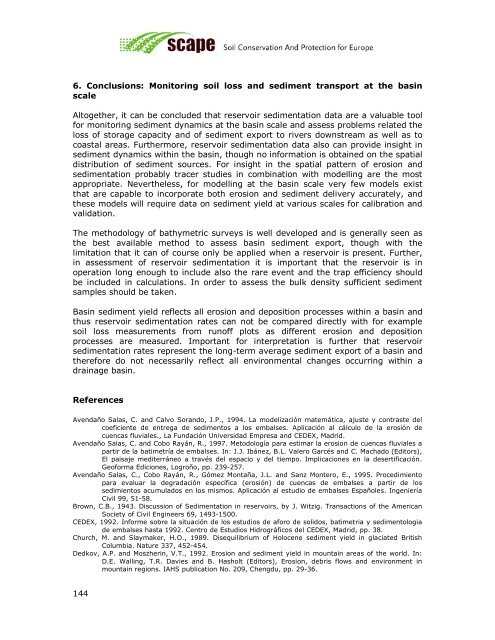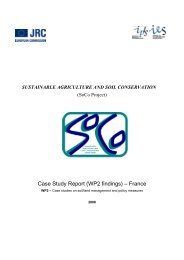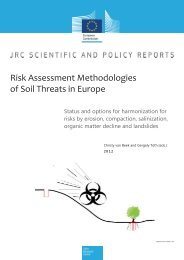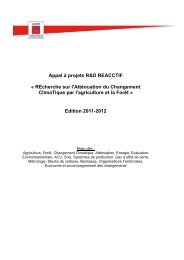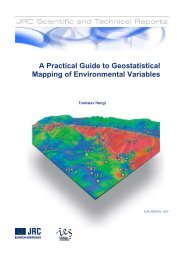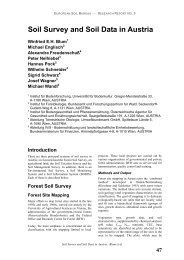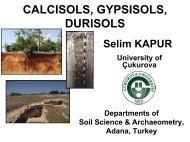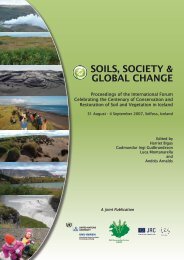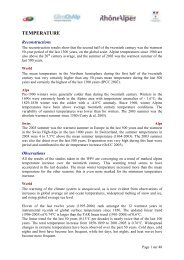Evaluation of reservoir sedimentation as a methodology for ...
Evaluation of reservoir sedimentation as a methodology for ...
Evaluation of reservoir sedimentation as a methodology for ...
Create successful ePaper yourself
Turn your PDF publications into a flip-book with our unique Google optimized e-Paper software.
6. Conclusions: Monitoring soil loss and sediment transport at the b<strong>as</strong>in<br />
scale<br />
Altogether, it can be concluded that <strong>reservoir</strong> <strong>sedimentation</strong> data are a valuable tool<br />
<strong>for</strong> monitoring sediment dynamics at the b<strong>as</strong>in scale and <strong>as</strong>sess problems related the<br />
loss <strong>of</strong> storage capacity and <strong>of</strong> sediment export to rivers downstream <strong>as</strong> well <strong>as</strong> to<br />
co<strong>as</strong>tal are<strong>as</strong>. Furthermore, <strong>reservoir</strong> <strong>sedimentation</strong> data also can provide insight in<br />
sediment dynamics within the b<strong>as</strong>in, though no in<strong>for</strong>mation is obtained on the spatial<br />
distribution <strong>of</strong> sediment sources. For insight in the spatial pattern <strong>of</strong> erosion and<br />
<strong>sedimentation</strong> probably tracer studies in combination with modelling are the most<br />
appropriate. Nevertheless, <strong>for</strong> modelling at the b<strong>as</strong>in scale very few models exist<br />
that are capable to incorporate both erosion and sediment delivery accurately, and<br />
these models will require data on sediment yield at various scales <strong>for</strong> calibration and<br />
validation.<br />
The <strong>methodology</strong> <strong>of</strong> bathymetric surveys is well developed and is generally seen <strong>as</strong><br />
the best available method to <strong>as</strong>sess b<strong>as</strong>in sediment export, though with the<br />
limitation that it can <strong>of</strong> course only be applied when a <strong>reservoir</strong> is present. Further,<br />
in <strong>as</strong>sessment <strong>of</strong> <strong>reservoir</strong> <strong>sedimentation</strong> it is important that the <strong>reservoir</strong> is in<br />
operation long enough to include also the rare event and the trap efficiency should<br />
be included in calculations. In order to <strong>as</strong>sess the bulk density sufficient sediment<br />
samples should be taken.<br />
B<strong>as</strong>in sediment yield reflects all erosion and deposition processes within a b<strong>as</strong>in and<br />
thus <strong>reservoir</strong> <strong>sedimentation</strong> rates can not be compared directly with <strong>for</strong> example<br />
soil loss me<strong>as</strong>urements from run<strong>of</strong>f plots <strong>as</strong> different erosion and deposition<br />
processes are me<strong>as</strong>ured. Important <strong>for</strong> interpretation is further that <strong>reservoir</strong><br />
<strong>sedimentation</strong> rates represent the long-term average sediment export <strong>of</strong> a b<strong>as</strong>in and<br />
there<strong>for</strong>e do not necessarily reflect all environmental changes occurring within a<br />
drainage b<strong>as</strong>in.<br />
References<br />
Avendaño Sal<strong>as</strong>, C. and Calvo Sorando, J.P., 1994. La modelización matemática, ajuste y contr<strong>as</strong>te del<br />
coeficiente de entrega de sedimentos a los embalses. Aplicación al cálculo de la erosión de<br />
cuenc<strong>as</strong> fluviales., La Fundación Universidad Empresa and CEDEX, Madrid.<br />
Avendaño Sal<strong>as</strong>, C. and Cobo Rayán, R., 1997. Metodología para estimar la erosion de cuenc<strong>as</strong> fluviales a<br />
partir de la batimetría de embalses. In: J.J. Ibánez, B.L. Valero Garcés and C. Machado (Editors),<br />
El paisaje mediterráneo a través del espacio y del tiempo. Implicaciones en la desertificación.<br />
Ge<strong>of</strong>orma Ediciones, Logroño, pp. 239-257.<br />
Avendaño Sal<strong>as</strong>, C., Cobo Rayán, R., Gómez Montaña, J.L. and Sanz Montero, E., 1995. Procedimiento<br />
para evaluar la degradación específica (erosión) de cuenc<strong>as</strong> de embalses a partir de los<br />
sedimientos acumulados en los mismos. Aplicación al estudio de embalses Españoles. Ingeniería<br />
Civil 99, 51-58.<br />
Brown, C.B., 1943. Discussion <strong>of</strong> Sedimentation in <strong>reservoir</strong>s, by J. Witzig. Transactions <strong>of</strong> the American<br />
Society <strong>of</strong> Civil Engineers 69, 1493-1500.<br />
CEDEX, 1992. In<strong>for</strong>me sobre la situación de los estudios de a<strong>for</strong>o de solidos, batimetria y sedimentologia<br />
de embalses h<strong>as</strong>ta 1992. Centro de Estudios Hidrográficos del CEDEX, Madrid, pp. 38.<br />
Church, M. and Slaymaker, H.O., 1989. Disequilibrium <strong>of</strong> Holocene sediment yield in glaciated British<br />
Columbia. Nature 337, 452-454.<br />
Dedkov, A.P. and Moszherin, V.T., 1992. Erosion and sediment yield in mountain are<strong>as</strong> <strong>of</strong> the world. In:<br />
D.E. Walling, T.R. Davies and B. H<strong>as</strong>holt (Editors), Erosion, debris flows and environment in<br />
mountain regions. IAHS publication No. 209, Chengdu, pp. 29-36.<br />
144


